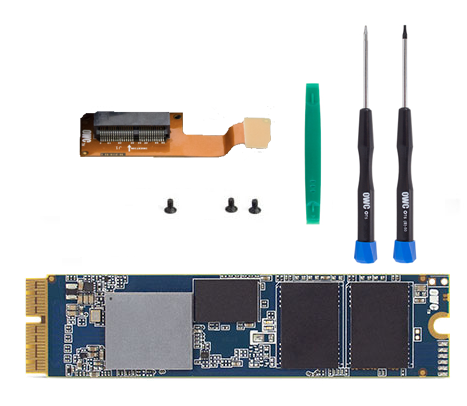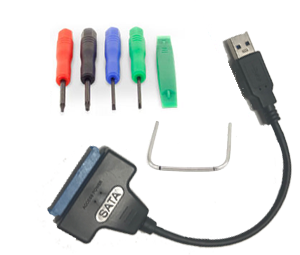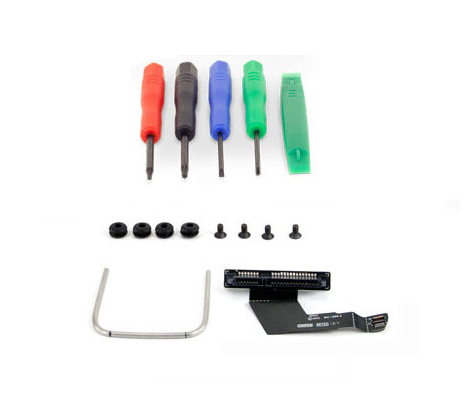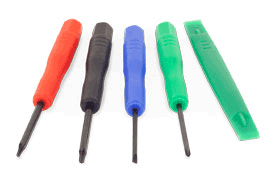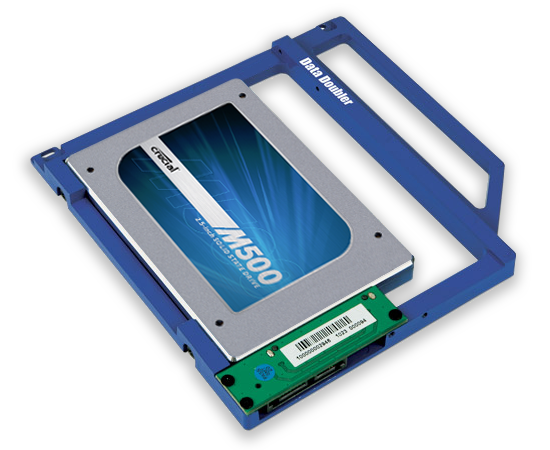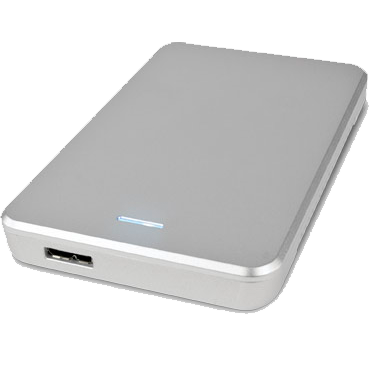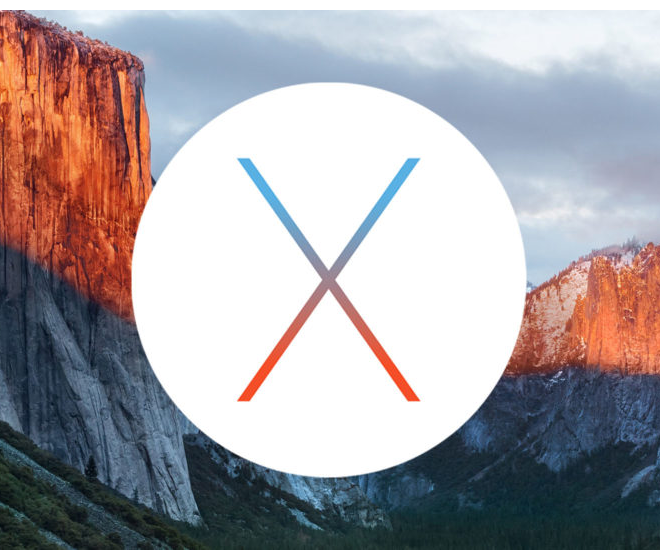How To Upgrade Your Mac Mini with an SSD (2020 updated)
The definitive guide
The Apple Mac Mini has a loyal fan group around the world. They are a hackers delight, in the true sense of the word. Hacking to make them more functional.
Whatever your use of the Mac Mini, be it media server or desktop computer, the one upgrade that will make the biggest impact is a SSD.
There are many options in upgrading a Mac Mini, and that is why we have created this guide. Everything we know, in one place, to help you the community get the most of your Mac Mini.
It is a free download if you want to save it to read later. We appreciate all feedback and additional information. In a way, we do rely on you the Mac Mini user to give us additional information. That will be added here, and shared with everyone else.
Don't forget to like and share if all this information has been helpful, that would be awesome...buying one of our SSDs would be even better :-)

Introduction
Normally we start these guides with why an SSD is fast, and why it will change your life. All Mac Mini users know this, they are use to sqeezing the most out of their machine to be more productive.
When ordering from Upgradeable, it is important to let use know you are upgrading a Mac Mini. Type your model number in the customer notes at checkout. This helps us provide you with all the right tools.
The way we structure these guides is by using our "Four R method". It is named this way because each step starts with the letter R.
REPLACE, RESTART, READY and RESTORE.
The idea is to present all the different ways to upgrade your Mini in a methodical and easy to remember format. If you need more detailed information or need help planning an upgrade, then please use our awesome customer service team. Yes, they answer the phone, like to be challenged with hard questions, and don't mind answering the easy ones too. There are no silly questions at Upgradeable, we are happy to help, even if it is just to make sure you are ordering the right product.
Chapters
Four R method: Time Machine

The easiest way to upgrade to a new SSD is to use Time Machine. All you need are tools and the SSD! You can either restore a whole back up, which includes macOS or you can migrate using the Time Machine after installing a new macOS.
REPLACE
Remove your old hard drive, and install SSD. We provide detailed printed instructions when you order an SSD, just include your Mac Mini model in the notes at checkout.
RESTART
Plug Time Machine into the USB port. If you have a wifi time capsule make sure it is turned on. Restart your Mac holding down the Command and R keys (this is Recovery Mode). The Mac will use the Time Machine to build the OS Utilities page.
READY
As the drive is shipped to you unformatted, you need to initialise the SSD to get it ready for the transfer of data. There is an option after you click into Time Machine called Disk Utility. You need to choose format type (must use APFS for Mojave or High Sierra, earlier versions use mac extended journaled) and a name, you can use Macintosh SSD or get creative and give it a person's name like MiniMouse. Click apply and this will format the SSD.
RESTORE
After formatting the drive your Time Machine back ups should be onscreen. Choose the latest, and the Mac will ask if you want to restore back up? Yes. Done. Time Machine will now start restoring onto the new SSD. It will take a while, approximately 100gb per hour.
Software and tools you need
The great thing about a Time Machine restore is you only need the SSD and tools to open the Macbook Pro.
• Screwdrivers (Phillips #00, Torx T6 and Spudger)
• Choose an SSD drive here
• Don't have a Time Machine backup? Read the Apple guide on Time Machine backups
Four R method: Cloning (2006-2014)
These are instructions for 2006 to 2014 Mac Mini .
Cloning allows you to make an exact copy of current hard drive to the new the SSD. The benefit is software does not have to be reinstalled.
The process is largely automatic and the cloning takes 2-5 hours depending on the size of your drive.

READY
Connect the SSD to a spare USB port using a USB to SATA cloning cable (sold separately).
RESTART
Restart your Mac
Do not allow macOS to turn it into a Time Machine drive.
RESTORE
Download and Install Carbon Copy Cloner software (30 day free trial software link is below in the green box). As the drive is shipped to you unformatted, you need to initialise the SSD to get it ready for the cloning by initialising the SSD. Clone your hard drive using Carbon Copy Cloner.
REPLACE
When cloning is complete, power off your Mac and replace the hard drive with the newly cloned SSD. We ship detailed printed instructions with your SSD order
Software and tools you need
Cloning is an excellent way to quickly copy your current drive onto a new SSD. You just need a cloning cable, SSD and tools to open the Macbook Pro.
• Screwdrivers (Phillips #00, Torx T6 and Spudger)
• USB to SATA cable (needed to connect the new SSD to your Macbook's USB)
• Carbon Copy Cloner download by Bombich (30 day trial).
• SuperDuper! software by Shirt Pocket (free download).
• Choose an SSD drive here
Four R method: Cloning blade SSD (2014)
The 2014 Mac Mini shipped a M.2 blade option for storage. The M.2 is a proprietary drive, which means you cannot use a standard NVME drive like the Samsung 970 EVO. The OWC Aura Pro X2 is a compatible SSD, however your Mac Mini must be on macOS High Sierra or above and the SSD formatted as APFS.
This method uses OWC Aura X2 with Envoy Pro and Internet Recovery to clone. If your Mac is pre 2010 then you will need a macOS installer USB (see note below on how to make one).

REPLACE
Power off your Mac and replace the original Apple SSD with the new
Aura X2 SSD. Install the Apple SSD into the OWC Envoy external case.
RESTART
Plug Envoy into USB. Restart your Mac holding down the Command and R keys (this is Recovery Mode). The Mac will build the OS Utilities page.
READY
Go to Disk Utilities and initialise the SSD. Must be initialised as APFS format.
RESTORE
In the left hand window pane of Disk Utilities select the new Aura X2. Click on Restore button on top menu. A pop up window will ask for “Restore from:” Select your original SSD that is in the Envoy case. Disk Utilities will now clone your old SSD onto the new Aura X2.
Software and tools you need
Our SSD KITS for the 2014 model includes everything you need to clone.
Kit includes SSD, printed instructions, and tools.
• Choose an SSD drive here
Four R method: Fresh macOS

Sometimes a Mac needs a fresh start. Apple makes it easy to reinstall macOS.
MacOS can be installed via Recovery Mode or via a macOS USB. We have previously recommended USB installers but Apple has updated and improved Recovery install. Restarting the Mac holding down Command - R will give you the OS previously installed. More detailed info is in our How to install macOS section.
READY
This method takes a little bit of planning. OSX or macOS (as it is now called) can be installed on an empty SSD via Recovery Mode or installing off media such as a USB. If you are installing from USB, you need to make that macOS USB before you start. Recovery Mode is installing the macOS from a Time Machine or a Mac drive recovery partition or Internet Recovery.
RESTART
Shut down your Mac.
REPLACE
Replace the hard drive (HDD) with the new SSD (reuse any mounting screws and brackets).
RESTORE
If you are installing macOS from USB, then insert macOS USB, hold down option key and restart Mac. If you are using Recovery mode, plug in your Time Machine or Mac drive (you dont need them if you have internet), restart the Mac holding down the Command + R keys. The Mac will create the macOS Utilities page that has options such as Disk Utility and install a new macOS. Whichever method you choose, the new SSD first has to be initialised (erased) first via Disk Utility. See How to install a macOS for detailed information
Software and tools you need
There are many options when starting fresh. You can install the current version of macOS or a later version that is more compatible with your apps and programs. You can put the latest macOS on your new SSD then use the Migration Assistant to copy over data and programs. You do not have to connect to another Mac, you can connect to a Time Machine or external startup disk to transfer files!
• Screwdrivers (Phillips #00, Torx T6 and Spudger)
• Familiar with how to Internet Recovery macOS or have an macOS USB drive.
• Choose an SSD drive here
The Upgradeable Team is here to help. If you want advice or check with an expert, please call, chat or email.
Second drive in DVD Bay (2009-10)

The 2009 and 2010 Mac Minis (not server version) can have two drives by replacing the optical drive with a Datadoubler bracket. Turn your Mac Mini into the server version. There are a lot of uses for a two drive Mac Mini: RAID the two drives, use the second drive as extra storage or a Time Machine. Please watch installation videos first to make sure you are comfortable do a complicated install. Alternatively, Upgradeable offers an instore installation service.
Physical installations
Fit the new drive on the Datadoubler bracket. Remove optical drive (DVD) and replace with the Datadoubler. (full printed instructions are included with order). We recommend watching installation videos first. You should now have two drives: your old hard drive and the new SSD in the optical bay.
Restart your Mac
Power on your Mac Mini holding down the option key (this starts the boot manager and shows all drive you can boot from). Your old hard drive should appear onscreen as a device to boot from. Select and start up macOS.
When the Mac starts up, do not allow the system to use the new SSD as a Time Machine.
Initialise the new SSD
The new SSD needs to be initialised (formatted). Open Disk Utility (in applications), select the new SSD. Click on Erase. Give the new drive a name such as "Macintosh SSD". You need to choose format type (must use APFS for High Sierra and above, earlier versions use Extended Journaled). Erase. The drive is now ready to be used.
How are you restoring macOS?
Will you be cloning your old drive onto the new SSD? Or using internet recovery or a macOS USB to install a fresh install of macOS. If you are cloning, install SuperDuper! software and clone your hard drive (in optical bay) to new SSD. If you are putting a fresh version of macOS on the new SSD follow the instructions listed in the Four R method: Fresh macOS
Two bootable drives
There are now two bootable drives, you need to make sure macOS uses the right one! In StartUp Disk (in system preferences) choose the new SSD as the drive the system uses to restart the Mac.
It is a good idea to use the new SSD for a while. Make sure everything is ok. If you do not need the 2nd drive as a backup and the new SSD is working perfectly you can erase the original drive in Disk Utility. The 2nd drive can be use as a Time Machine for back ups or use as internal storage.
Software and tools you need
This upgrade is complicated, so we provide printed illustrated guides and free phone tech support if you need help.
• Data Doubler bracket for Mac optical bay
• SuperDuper! software by Shirt Pocket (free download). Or familiar with how to Internet Recovery macOS or have a macOS USB drive.
• Choose an SSD drive here
The Upgradeable Team is here to help. If you want advice or check with an expert, please call, chat or email.
Second drive in 2011-12 models

The 2011 and 2012 (non server) Mac Mini models Mac Minis can have a second drive installed. Upgradeable sell a kit that includes all the tools, accessories and cables you need. Please watch installation videos first to make sure you are comfortable with this complicated install. Alternatively, Upgradeable offers an instore installation service. WARNING: some 2012 models shipped from Apple with the original drive in the upper bay not the usual lower bay. One of our steps below show you how to check. It is not a big issue, the same cable is used but in a different way.
Check location
To check the drives location, open Disk Utility and click on the grey drive icon at the left edge of the window. Click the "Info" button on the toolbar. A window will open. Scroll to the "Location" item; if you see "Lower" Do a standard installation. If it lists "Upper" then watch this install video and you will need a small wrench.
Physical installations
Fit the new drive in the lower or upper bay (which ever is empty, should be "upper").
Full printed instructions are included with order.
We recommend watching the installation videos first.
You should now have two drives installed.
Restart your Mac
Power on your Mac Mini holding down the option key (this starts the boot manager and shows all drive you can boot from). Your old hard drive should appear onscreen as a device to boot from. Select and start up macOS. If neither drive has an OS, then us Recovery Mode or plug in a MacOS USB installer.
Initialise the new SSD
The new SSD needs to be initialised (formatted). Open Disk Utility (in applications), select the new SSD. Click on Erase. Give the new drive a name such as "Macintosh SSD". You need to choose format type (must use APFS for High Sierra and above, earlier versions use Extended Journaled). Erase. The drive is now ready to be used.
How are you restoring macOS?
Will you be cloning your old drive onto the new SSD? Or using internet recovery or a macOS USB to install a fresh install of macOS. If you are cloning, install SuperDuper! software and clone your hard drive (in optical bay) to new SSD. If you are putting a fresh version of macOS on the new SSD follow the instructions listed in the Four R method: Fresh macOS
Two bootable drives
There are now two bootable drives, you need to make sure macOS uses the right one! In StartUp Disk (in system preferences) choose the new SSD as the drive the system uses to restart the Mac.
It is a good idea to use the new SSD for a while. Make sure everything is ok. If you do not need the 2nd drive as a backup and the new SSD is working perfectly you can erase the original drive in Disk Utility. The 2nd drive can be use as a Time Machine for back ups or use as internal storage.
Software and tools you need
This upgrade is complicated, so we provide printed illustrated guides and free phone tech support if you need help.
• Second drive kit for 2011 and 2012 Mac Mini
• SuperDuper! software by Shirt Pocket (free download). Or familiar with how to Internet Recovery macOS or have a macOS USB drive.
• Choose an SSD drive here
The Upgradeable Team is here to help. If you want advice or check with an expert, please call, chat or email.
SSD options for the 2014 Mac Mini

The 2014 model could be configured from the Apple factory with THREE different storage options.
1. SSD = m.2 PCIe blade
2. SATA drive = 2.5 inch SATA hard drive
3. Fusion drive = both a PCIe SSD and SATA drive installed.
Upgradeable sells kits for every configuration
M.2 PCIe SSD 2014 Mac Mini
You can replace your SSD with a larger faster Aura X2. You can not add two PCIe SSD blades. If you want a second drive, there is a SATA port on the motherboard. We sell a kit that includes tools and cable required to add a SATA SSD in the empty SATA drive bay.
SATA hard drive 2014 Mac Mini
You can replace your SATA drive with a faster 2.5 inch SATA SSD. There is no room in the model for two SATA drives as in previous models. To add a second drive you must add a PCIe cable. There is a free PCIe port on the motherboard. Upgradeable sells a kit (see the green box below) that includes tools and cable required to add a PCIe SSD (Aura Pro X2) to your Mac Mini.
Fusion Drive 2014 Mac Mini
If your Mac Mini 2014 shipped from Apple with a fusion drive, then your Mac Mini has both the SATA and the PCIe connector. You can replace the SATA drive with a 2.5 inch SSD and you can replace the original Apple SSD with a faster Aura Pro X2 NVMe SSD.
Software and tools you need
All these upgrades are complicated, but we do provide printed illustrated guides and free phone tech support if you need help.
• Add a SATA connector kit to a Mac Mini 2014 for models that shipped with a SSD only.
• Add a PCIe connector kit to a Mac Mini 2014 for models that shipped with a SATA drive only.
• Choose a 2.5 inch SATA SSD here
• Choose a PCIe blade SSD here
The Upgradeable Team is here to help. If you want advice or check with an expert, please call, chat or email.
Choose an SSD for your Mac Mini
These SSD drives are a standard 2.5 inch SATA drive, compatible with the 2005 to 2012 Mac Mini range.
The 2014 model also had a SATA option, please see our notes on upgrading.
$ 453.00
9 in Stock
$ 226.00
16 in Stock
$ 123.00
18 in Stock
$ 83.00
11 in Stock
Add a second drive kit for your Mac Mini 2014
2TB OWC Aura Pro X2 SSD with PCIe 2nd drive kit Apple compatible
Part No: UA1070
$ 1,392.00
Ships in 1-2 days
1TB OWC Aura Pro X2 SSD with PCIe 2nd drive kit Apple compatible
Part No: UA1069
$ 636.00
Ships to you on Monday
$ 377.00
Ships in 1-2 days
Let us do all the work!
Not everyone wants to do their own installation. We are working with qualified technicians to offer an onsite and instore installation service. This is a new service, not all areas are covered. Please contact our office for more details.
Accessories you need for a DIY installation
These are the kits or parts you need for a successful installation of your SSD. Add to your cart what you need with the SSD you have chosen. When checking out, don't forget to tell us in the customer notes which Macbook or Macbook pro you have, and we will include full printed instructions.
$ 37.00
< 5 in Stock
How to install macOS
Note: It appears Apple has removed the feature to get a new macOS via Internet Recovery. All key commands now install the original macOS that came with your Mac. For example; if you have an older Mac that shipped with Lion, then internet recovery will install that version on your Mac. The only way to get a newer version of macOS is via macOS Utilities on Time Machine or a recovery partition on a Mac drive (such as your old hard drive).
From mid 2010-2011, most Macs shipped with part of the macOS embedded in the logic board. This allowed the Mac to do an Internet Recovery, go to the Apple website, download some software, and boot to the macOS Utilities page. From this page you could initialise a new drive and install the latest macOS. Changes from the release of High Sierra mean that the only macOS you can install via Internet Recovery is the version you have embedded on your logic board (the macOS that shipped with your Mac). We are still testing different scenerios, if you have experienced something different, please let us know.
Why is this an issue?
From Sierra and High Sierra, Apple has a new drive format structure. When you upgrade to High Sierra, Apple changes your drive format structure to APFS. High Sierra will only reliably work on a drive formatted as APFS. To control how the latest macOS is installed, Apple has locked down ways to install it. If you internet recover your macOS, you can not format your drive as APFS and you can not install the latest macOS. To get the latest macOS you need a recovery partition created with one of the latest macOS (like High Sierra).
With the dramatics out of the way, there are various ways to install macOS on your Mac, Apple provides many options. This quick guide is designed to answer questions you have and provide a bit of clarity on the different processes. This is based on our experience and is always being revised. If you can add to these guides, please contact us accordingly.
How to get the latest macOS on a new SSD?
If you don't have a Time Machine or a working mac drive with the latest macOS then you only have one option. You have to create a macOS USB drive.
If you have a Time Machine or a working Mac drive, you can boot off either device to start the macOS Utilities page which gives you the option of Disk Utility (to initialise the new SSD) and also install a new macOS. That macOS will be the version of macOS that is backed up on the Time Machine or the macOS that created the recovery partition. So if your drive or Time Machine was created with Sierra, then that is the macOS you can download and install. You can not install High Sierra or Mojave. The latest macOS is only available via an upgrade path. So install Sierra, and then use App Store to upgrade to High Sierra or Mojave. To use Time Machine restart your Mac while holding down the option key. If you restart the Mac holding down Command + R it could use an old recovery partition or Internet Recovery. If you are using a recovery partition you can restart the Mac holing down the option key (recommended as you can see which drive it reboots from) or holding down Command + R.
Using your old drive to get a new macOS
Your current hard drive will most likely have a recovery partition. Plug your new SSD into the Mac using a USB-SATA cloning cable. Reboot the Mac holding down keys Command (⌘)-R. This should make the Mac boot from the recovery partition. If a spinning globe of the world appears, then it is going to Apple website to install an older version of MacOS, so cancel that operation or shut the Mac down via a hard power off (hold down power button). You need to restart holding down the option key, select the recovery partition on the drive that appear. What should happen is the Mac will build The "macOS Utilities" page giving you the option of installing a new macOS (there are also options to restore from Time Machine and Disk Utility).
Using your Time Machine to get a new macOS
Plug the Time Machine directly into your Mac. Hold down the option key and reboot the Mac. Holding down the option key loads the boot manager and the Time Machine drive should appear onscreen. Select the Time Machine and the macOS Utilities page should come onscreen. You will have the option of installing a new macOS (there are also options to restore from Time Machine and Disk Utility).
If a spinning globe of the world appears, then it is going to Apple website to install an older version of MacOS, so cancel that operation or shut the Mac down via a hard power off (hold down power button). Your Mac is not seeing the Time Machine. Make sure there is a physical connection not wifi. Is the Time Machine turned on? Try holding down keys Command (⌘)-R and restarting with the Time Machine plugged in.
Options for older Macs
You can install MacOS via original Apple disks. Apple no longer makes MacOS disks, DVD, CD or physical media. All MacOS software is delivered digitally. If you have original software media for an macOS like Snow Leopard you can install that software and then upgrade via the App Store to the current version. Use the current MacOS upgrade guide for more information.
If you are using Leopard, you need to first buy Snow Leopard OSX 10.6 media from Apple to upgrade the MacOS digitally. You can buy from an Apple Store or calling Apple Support.
Common problems installing a new macOS
The Recovery Server Could Not Be Contacted This issue is nearly always caused by an incorrect date on your Mac. If you have disconnected the battery, the date could have reset. Part of macOS Utilities is Terminal. It is found as an option in the top menu. Select Terminal. If you are connected to the internet then type:
ntpdate -u time.apple.com
This should update the time. If not, then use this manual method:
date 0201200019
which is February 1st 20:00 (or 8pm) 2019.
So mmddhhmiyy
all two digits.
macOS High Sierra or Mojave is not available If you can not see the latest operating system in macOS Utilities then you have booted off the wrong partition. Either there is an old partition on Time Machine or on the Mac drive. This usually happens when the Mac is restarted using Recovery Mode (command + R). Apple and most of the internet recommends this method, however it does not give you control over which partition the Mac recovers from. Holding down the option key and restarting the Mac goes into boot manager, and you can see all the drives the Mac can boot from. Make sure you choose the right one! If you are recovering using a Time Machine, do not select a recovery partition, select the external USB time Machine.
Can not boot from Time Machine
From OS X Lion v10.7.3 or later, you can start up from your Time Machine disk. Hold down the Option key as your Mac starts up. When you see the Startup Manager screen, choose “EFI Boot” as the startup disk. The system should create the macOS Ulitilies page. From here you can use disk utilities to format a new SSD, you can restore from Time Machine or install a new macOS from the Apple servers. If you can not boot from the Time Machine, it is certainly something to do with your EFI. We are still troubleshooting this, we will have a new section on EFI shortly. You can google macOS EFI update to see the issue some mac users are having. It appears Apple updates the EFI in the background during macOS updates. If it fails, there is no warning or notification. So there are a lot of Macs with outdated EFI. If your EFI is current, we have not seen any issues with High Sierra/Mojave or booting from Time Machine. If you are having issues installing High Sierra or Mojave, please check if your EFI is update.
USB Installer is corrupted
The error message when installing OS X is "This copy of the install OS X El Capitan application can't be verified. It may have been corrupted or tampered with during downloading". This is a check Apple has introduced with system installation. They don't want old OS versions installed, better to move everyone to new OS, and new hardware (buy a new mac). There is a simple work around. Reset your system date to OS release date or close to OS release date and you can now install the OS.
If you are in OS Utilities, the top menu should have a drop down that has Terminal. Run terminal and then type this in:
For El Capitan install use: date 1001200015 [enter]
You can check the date is now 2015 by typing: date [enter], it should now display: October 1st 20:00 (or 8pm) 2015. The date after El Capitan's release. You can now install El Capitan without an error.
Dates for other systems are:
Yosemite: date 1017200014
Mavericks: date 1023200013
High Sierra: date 1023200017
How to use Migration Assistant
Apple includes an awesome app called Migration Assistant that we have used to help customers start over with a fresh macOS but keep all their data and applications. Apple allows a lot of different installation and migration options. We will discuss the main ones here, but if this does not answer your migration question, please contact us for more specific information about the upgrade you are planning.
What is Migration Assistant...why should I use it?
Migration Assistant allows you to transfer applications, settings and data from another Mac. macOS can see "another Mac" as your old hard drive or a Time Machine back up. A mac can boot from an external drive, for example, if you put your old hard drive into an external enclosure, you can boot from it, and run that hard drive and it would be exactly the same as your old mac...because it is!
If you just want a new macOS, start fresh with no legacy upgrade data, then you can use Migration Assistant to reinstall all your data and apps, and you will have the benefit of a new macOS with all the apps and data from your old drive.
How to use Migration Assistant
After you have installed the new macOS, the system starts and asks for generic information: country, keyboard type etc. The next part of the installation setup is Migration Assistant.
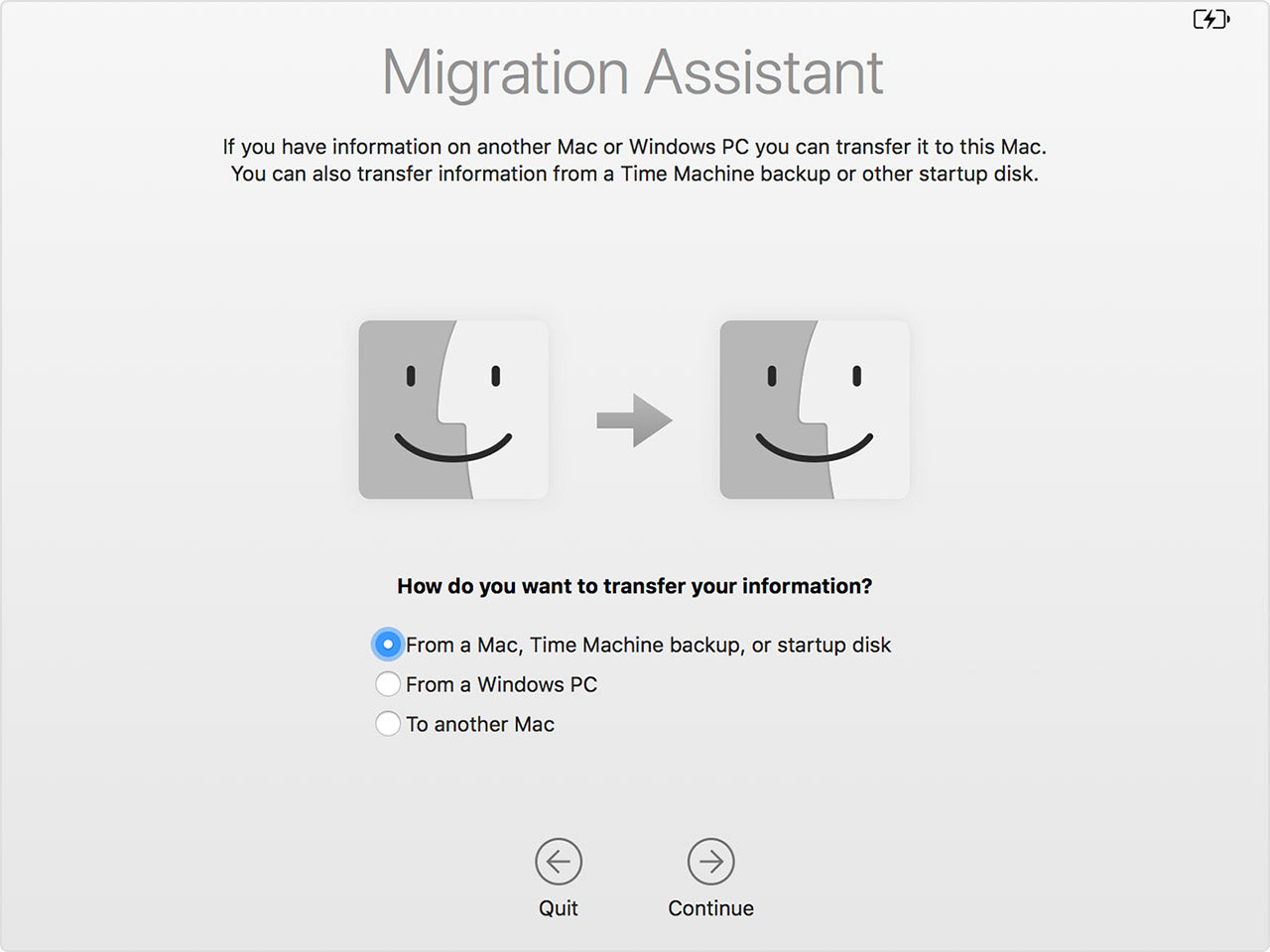
If you have installed a new SSD, you can use either your old hard drive in an external enclosure or a Time Machine back up as a source for Migration Assistant.
The example in the image below, a Time Machine disk is connected and to be used

Select the machine you want to restore from in Time Machine
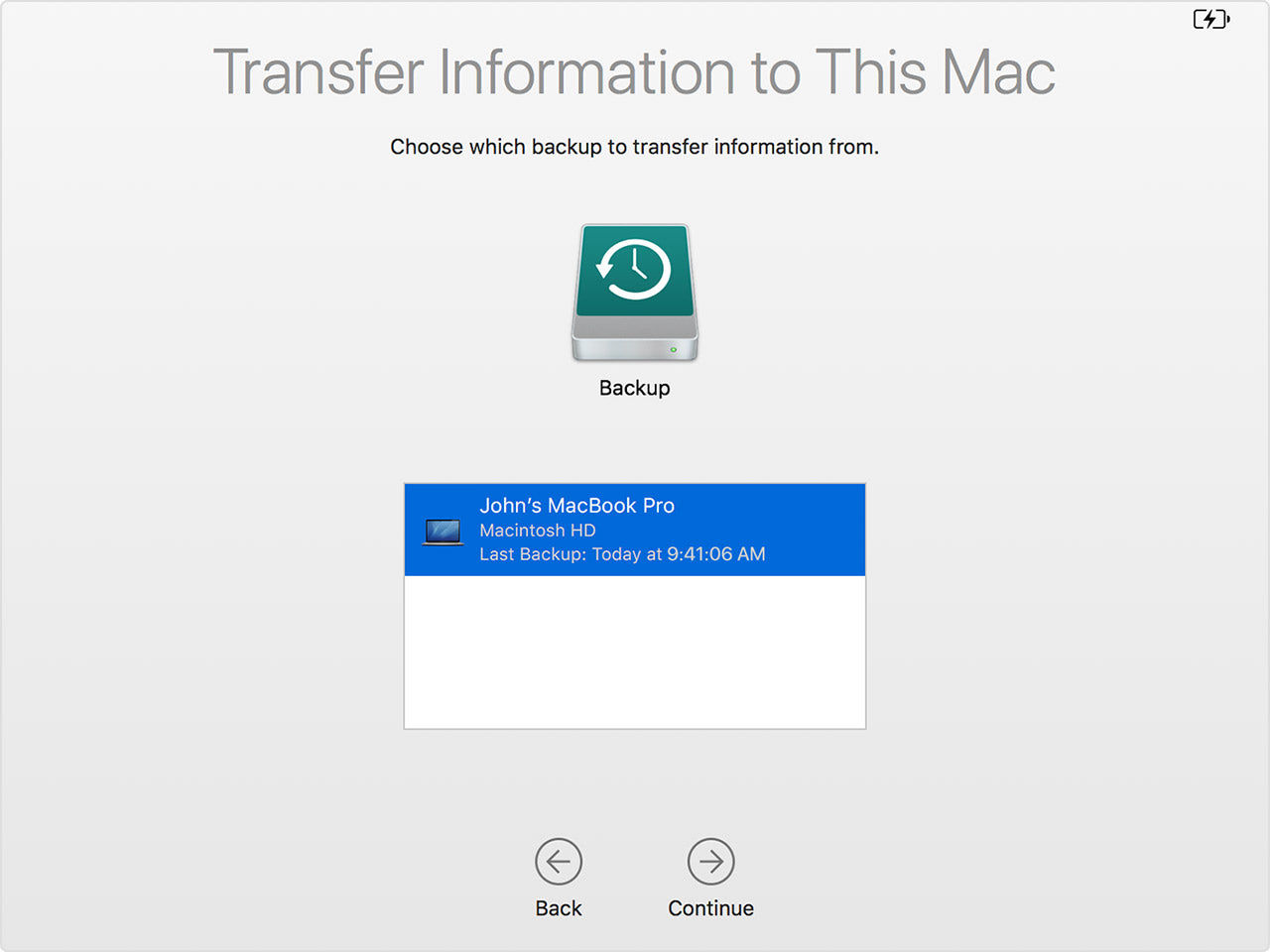
Then select the type of data you want to migrate
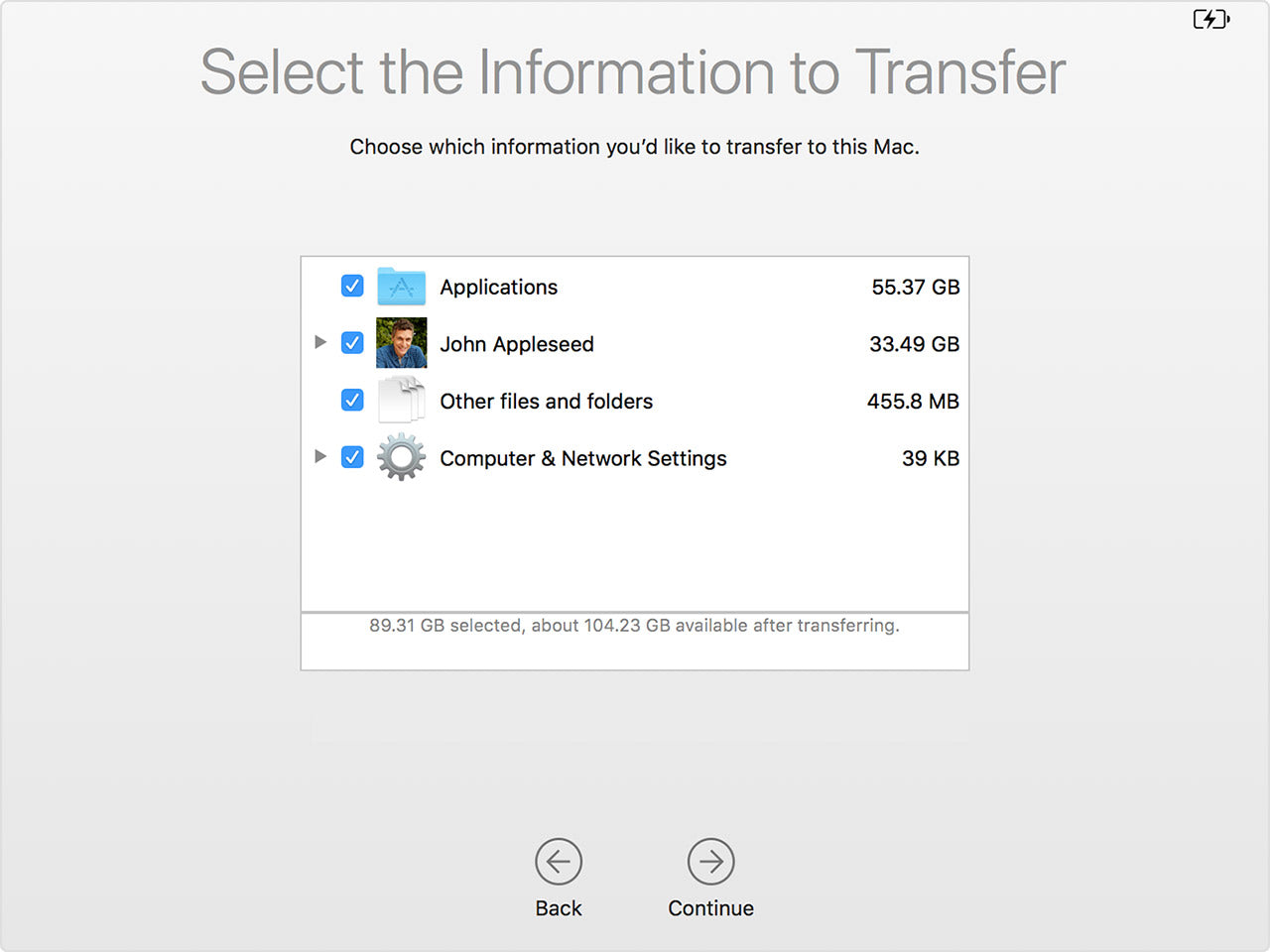
That is it! You should have a new macOS with all your applications and data restored back on the system.
Limitations of Migration Assistant
The new Mac can not be on Lion (v10.8) or earlier. If you are migrating to an old version of OSX such as Lion, then you need to use another method.
This method is not recommended if the macOS are too far apart in release. It is ok if you are moving from Sierra to High Sierra. But if your computer is on Lion, your application and core system files will not be compatible with High Sierra or Mojave.
Time Machine: the Good, the Bad and the Ugly
We have renamed this section the good, the bad and the ugly. These are the undocumented or little known Time Machine features that can make your life easier or harder when upgrading to an SSD.
THE GOOD
First the most asked question we get: Does Time Machine back up the operating system or macOS?
If your Time Machine is backing up your whole drive, yes the macOS is backed up. You have a complete back up of your Mac. You do not have to download macOS to use your Time Machine. In Sierra and High Sierra we have seen Time Machine go off to the Apple website to verify or update core files. It is not totally understood what is happening, but it is not uncommon for Time Machine to get additional files from the Apple website before restoring a Time Machine back up. Usually these files are to do with the recovery partition on the Time Machine or the Disk Utilities page.
Restore on a new macOS
You can install a new macOS onto your Mac and then restore a Time Machine backup and not overwrite the new macOS. In our tests, we have found Apple has separated out the OS and the data. If Time Machine sees there is a macOS installed on the SSD, it will not overwrite these files, but just restore the data. You can enjoy a new macOS on your new SSD, and then restore your data without affecting the new macOS.
This is good for customers with High Sierra/Mojave on Extended Journal formatted drives. You can reinstall High Sierra/Mojave on a new SSD with APFS format, then restore from Time Machine and you will keep the APFS format, have all your data moved over.
The bad is for customers that have installed an older macOS, such as Lion, via internet recovery. If you then restored from Time Machine on top of this Lion macOS then Time Machine will not overwrite the Lion files, and you will create a Mac that can not boot on the new SSD. If you install the wrong macOS on your new SSD, the SSD must be erased using Disk Utility, and then the Mac can be restored from Time Machine.
Rebooting off Time Machine
Time Machine does not have a recovery partition, however you can use it to restore your Mac or install a new macOS. If you want to use Time Machine in this way, plug the Time Machine into the Mac, then restart the Mac holding down the Option key. This loads the boot manager and you can see all drives attached to the Mac. The Time Machine should display as an external drive. Select it and the Mac will build a macOS Utilities page that will have Disk Utility (to initialise a new drive or erase a current drive) and install a new macOS.
THE BAD
The biggest issue we currently have with Time Machine is restoring onto a new SSD with High Sierra or Mojave. We have written about this before: to run High Sierra or Mojave on an SSD without problems the SSD must be formatted to APSF, not macOS Extended Journal. If you have a mechanical hard drive and have upgraded to High Sierra or Mojave, most of the time this drive is formatted as Extended Journal. When you restore from Time Machine onto a new SSD, Time Machine recreates the whole structure. It will name the SSD the same as the old hard drive (even if it is preformated and named different) and it will format the drive as the same as the one on the Time Machine, which is usually Extended Journal. There is no way to change to APFS without erasing the SSD. This is the problem. Currently we have two work arounds. The easy one is clone the drive do not restore from Time Machine. By cloning, you can format the new SSD as APFS, and then the clone will copy all the old files onto the new SSD with the right APFS format. The second work around is installing a fresh OS using a macOS installation USB and then restoring Time Machine on top of the new OS. Time Machine will restore the data but not overwrite the new OS.
THE UGLY
This one might be a bit pedantic but it annoys the hell out of me. When you restore from Time Machine it restores everything including the disk name. It is the disk name duplication that kills me every time. You erase your new SSD, give it a clever name like Ernie because your current hard drive is called Bert. You restore from Time Machine and the SSD is now called Bert. What happened to Ernie? Ok, I know, you can go and rename the drive to Ernie but what if this is a second drive. Both drives are called Bert, how do you know which one is which? It is important, because you need to set the new SSD as the start disk in preferences. You can not rename the drive in disk utilities but you can change the name on your desktop. So go to the desktop, you will see two drives, both with the same name. You can click twice on the name slowly and it will highlight so you can rename it. Then go to Disk Utilities see which drive you changed. You should be able to see details like SSD brand name, which will make it obvious which is the new SSD. That way you can work out which is the new SSD and which one should be renamed Ernie.
How to create a macOS USB
There are a lot of options to create bootable USB to install macOS. We have recommended Diskmaker X in the past but the method we outline here is the recommended method from Apple.
This is our summary of how to make a Mojave macOS USB drive. With this drive you can install macOS on a blank SSD or boot from this USB and use the tools and utilities to check or format a Mac drive.
Download Mojave
Go to the App Store, search for macOS Mojave and download. For High Sierra click here. After it has downloaded it should appear in your Applications as "Installer MacOS". If you have already downloaded and upgraded to Mojave or High Sierra you will need to download the MacOS you want again (Apple deletes installer once it has been used).
8GB USB
You need at least an 8GB USB drive. It does not have to be a super fast USB 3.0 version, and older one can be repurposed. It does not have to be a USB. You can use an external hard drive (note: any data on the drive will be lost as it gets formatted). Go into Disk Utilities and rename the USB to "upgradeable". You can erase and rename. The MacOS creation method will reformat the drive, so it does not need to be any specific format type like Fat32 or Mac Journaled. What is important is the name of the drive, as it is used in the code below.
Using Terminal
We are going to use the command line app called Terminal to create the MacOS drive. Don't worry if you have never used it, it is very easy, not that scary. Open Terminal, it is found in the Utilities folder in Applications.
Copy this code
Copy this code:
sudo /Applications/Install\ macOS\ Mojave.app/Contents/Resources/createinstallmedia --volume /Volumes/upgradeable
Paste the code
Paste the code you copied into Terminal and hit enter. It will ask for your system password (usually the one you log on with at start up). Type Y and return when it asks if you want to erase this drive. When it is finished creating it will display "Copy complete". You can close Terminal.
How to use the USB
When the USB or external drive is plugged in, restart the Mac holding down the Option key. The USB will appear on screen as Install MacOS. Select and hit return. You do not need to select a network. If you are installing the macOS on a new SSD it will need to be initialised. Go into Disk Utility, Erase and name. Proceed to install macOS. Please note Apple have added a new format type in High Sierra and Mojave. If you are starting with a new macOS, like Mojave, then Apple recommends you use APFS and not Mac Extended Journal. APFS is a new format specific designed for High Sierra and above macOS and optimised for SSD drives.
How to initialise an SSD
When you get your new SSD it is uninitialised. This means it can be used in a Mac or PC. It needs to be initialised before use. In the PC world they call this formatting the drive. In the Mac world it is called Erase and it is a function of Disk Utilities
Disk Utility is a tool included in many places. It is found in the Utilities directory in Applications. It is included in any macOS install app. It is found in the recovery partition on a drive when a Mac is restarted holding down the keys Command + R. It is also a part of the Internet Recovery boot up. There are many reasons why you would want to erase a drive, this guide is focused on initialising a new SSD, however for readers who are looking at general information we have added the following warning...
Warning: Erasing a disk will delete all data on the disk. Never initialise/erase a drive that has data on it that you want to keep. I know that sounds obvious but you would be surprised with the support calls we get :-). Four steps to initialise a new SSD.
New APFS format in High Sierra and Mojave
Starting from macOS High Sierra, Apple have a new format called APFS. It is recommended to format your new SSD in APFS if you will be using High Sierra or above. APFS is optimised for SSD drives. If you are using macOS Sierra or below, the recommended format is still Mac OS Extended (Journaled).
Open Disk Utility
When you start Disk Utility, in the sidebar are the drives attached to the Mac. Select the disk name, not the indented volume name.
Erase button
Click on the Erase button. If there is no erase button select the drive again.
Options
There are two to three fields that need to be selected.
Name: Enter a name for your disk, such as "Macintosh SSD"
Format: Choose APFS (for High Sierra or Mojave) or Mac OS Extended (Journaled) for earlier macOS like El Capitan
Scheme (if available): Choose GUID Partition Map

ERASE
Click the Erase button and the SSD will be ready to use.
How to clone with SuperSuper!
Please note: this process cannot be used to clone a Windows partition created by Boot Camp. We recommend WinClone by Twocanoes Software. It is commercial software requiring a license to use, however it is not affiliated with our company and that is not an affiliate link.
Before cloning, the SSD needs to be initialised, if that has not been done, please follow our instructions above.
The process is really only two steps...download and run. Superduper! is very simple but powerful piece of software.
Download and install
SuperDuper! software by Shirt Pocket (free download).
When the download is complete, install in your Applications folder.
Double click on the SuperDuper! icon to run
Clone
Choose your source (Macintosh HDD) and destination (Macintosh SSD) drives. Click Copy Now to begin. You will be notified when it is complete.
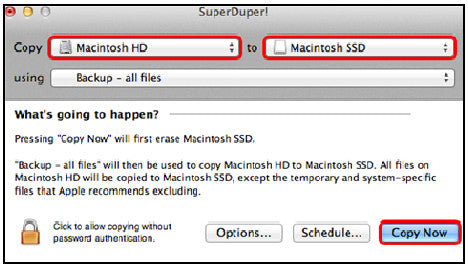
Simple Questions answered
Is the SSD the same physical size as my current hard drive?
Yes. The standard Apple Mac Mini 2006-2012 hard drives are an industry standard 2.5 inch notebook drive. They are physically exactly the same physical size.
Can I use any SSD here to upgrade my 2014-2019 Mac Mini?
No. From 2014 the Apple Mac Mini SSD was a proprietary NVME SSD. The 2019 Mac Mini SSD was soldered onto the motherboard and can not be removed or upgraded.
Does the 2014 Mac Mini use a standard M.2 SSD?
No. It is only standard in it's physical size. A standard M.2 drive will not work. Apple has made their drives proprietary.
Are the 2.5 inch SSD drives faster or better the larger the size?
All our current SSDs are the same speed and quality. The 250GB is as fast as the 2TB.
Do I need a bracket to install the SSD?
No.
Can I do this install myself?
Yes. We have had customers of every type of experience: students to pensioners do this upgrade. It is only slightly more complicated than a RAM upgrade.
Do I need any special tools?
For the pre 2013 models you need a small phillips screwdriver and a Torx 6 screwdriver. These are standard tools, found in many kits and available at hardware stores like Bunnings. Everything you need is in our screwdriver tool kit. The Aura SSD kits include all the tools you require.
Can I clone a bigger drive onto a smaller SSD?
No. If you have 900gb of data on a 1TB hard drive, you can not clone this onto a 525GB SSD. The cloning software we recommend does not selectively clone. It is all or nothing.
Does the hard drive and the SSD have to be the same size?
No. As long as the source (current hard drive) has less data than size of the new SSD. So 300GB on a 1TB hard drive will clone onto a 525GB SSD.
What size SSD should I buy?
We recommend you look at how much data is on your hard drive and then get an SSD at least 20% bigger than the data you have. We have found the optimal free space for an SSD to work with virtual and swap files is 20%. Aim for 30 to 40%. It all depends on your work flow and how much data you store and delete.
Can SuperDuper! clone a windows parition?
No. We recommend Winclone for this type of clone.







